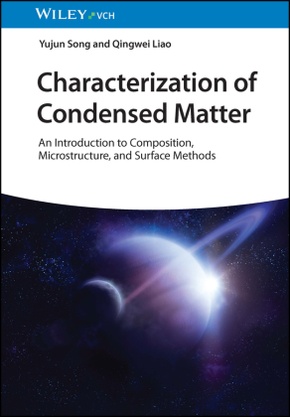
Characterization of Condensed Matter - An Introduction to Composition, Microstructure, and Surface Methods
| Verlag | Wiley-VCH |
| Auflage | 2023 |
| Seiten | 368 |
| Format | 17,5 x 2,2 x 25,0 cm |
| Gewicht | 850 g |
| Artikeltyp | Englisches Buch |
| ISBN-10 | 3527351094 |
| EAN | 9783527351091 |
| Bestell-Nr | 52735109A |
Ein umfassendes Buch, in dem wesentliche Techniken zur Charakterisierung der Struktur und Zusammensetzung kondensierter Materie sowie die jeweiligen Grundlagen, benötigten Instrumente und möglichen Anwendungen dargestellt sind.
A comprehensive book that includes essential techniques with their fundamental, instrumentation and application in structural and composition characterization of condensed matter.
Inhaltsverzeichnis:
PART I. Fundamental of Universe, Matter, Condensed Matter and Crystallography
Chapter 1. Universe, Matter, Condensed Matter and Materials
Chapter 2. Laser Interferometer Gravitational Wave Observatory
Chapter 3. Fundamentals of Crystallography for Microstructure Characterization of Condensed Matter
PART II. Electromagnetic Spectroscopy
Chapter 4. Element of X-Ray Diffraction
Chapter 5. X-Ray Fluorescence Spectroscopy (XRF)
Chapter 6. X-Ray Emission Spectroscopy (XES)
Chapter 7. X-Ray Absorption Spectroscopy (XAS): X-Ray Absorption Near Edge Structure (XANES) and Extended X-Ray Absorption Fine Structure (EXAFS)
Chapter 8. X-Ray Raman Scattering (XRS(
Chapter 9. Fourier Transform Infrared Spectroscopy (FTIR)
Chapter 10. Energy Dispersive X-Ray Spectrum of Elements (EDX)
PART III. Characterization Methods Based on the Particle (Electron or Electron Beam, Neutron)-Matter Interaction
Chapter 11. Scanning Electron Microscop e (SEM)
Chapter 12. Transmission Electron Microscope (TEM)
Chapter 13. Spherical Aberration Corrected Transmission Electron Microscope (SAC-TEM)
Chapter 14. Environmental Transmission Electron Microscope (ETEM)
Chapter 15. Holography
PART IV. Characterization Methods for Hyperfine Structures Related to the Magnetic Properties of Electrons and Nuclei
Chapter 16. Nuclear Magnetic Resonance Spectroscopy
Chapter 17. Mössbauer Effect and Mössbauer Spectroscopy
PART V. Surface Analysis Method
Chapter 18. Atomic Force Microscope (AFM)
Chapter 19. X-Ray Photoelectron Spectroscopy (XPS)
PART VI. Some Progress and Perspective
Chapter 20. Instrumentation Based on Fundamental Progress in Interaction Electromagnetic Wave and Matter, and Electron-Matter Interaction
